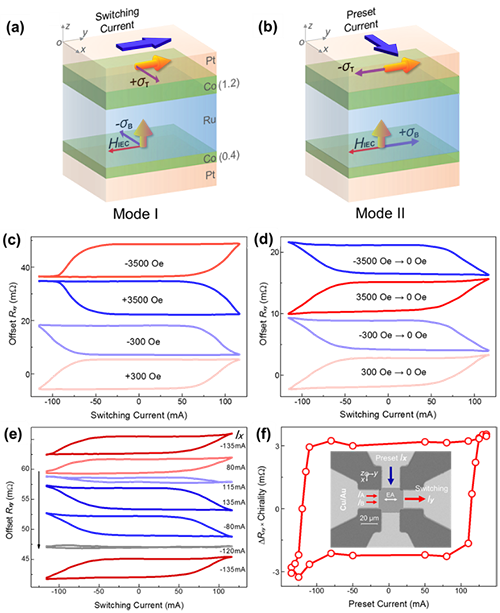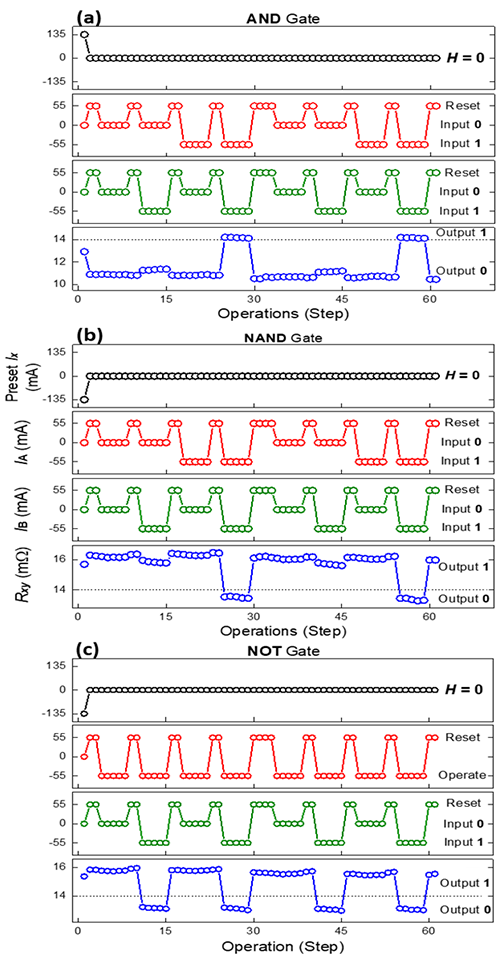Research progress on an all-electrically controlled nonvolatile multi-functional programmable Spin Logic device
Date:11-09-2018 Print
In the era of big data, spin-based data storage and computing techniques bring about potential solutions to provide much more computing and storage capability than classic electronics. Magnetic random access memory (MRAM) and Spin Logic devices are the key technologies that spintronics provides to solve these challenges in storage and computing fields, respectively. Their common material and physics foundations are (1) magnetic tunnel junction (MTJ) materials with high magnetoresistance ratio and (2) mechanism of current-driven magnetization switching. The second foundation is also the standard to categorize MRAM generations. The first and second generation MRAM write data using current-induced Oersted field and spin-polarized current-induced spin transfer torque (STT) effect, respectively. Compared with the 1st generation of MRAM, the 2nd generation of STT-MRAM has outstanding advantages in power consumption and reliability. Therefore STT-MRAM is expected to be soon embedded into microelectronic devices and becomes the second widely used spintronic device since the reader of hard disk.
Recent discovery and progress on spin-orbit torque (SOT) effect and related current-controlled magnetization switching phenomena have agitated another upsurge of exploring new spin storage and logic technologies. These novel spintronic devices based on SOT have not only the features of non-volatility, low power consumption, CMOS compatibility and radiation-robustness inherited from nature of STT effect, but also the advantages of high speed, long endurance and high thermal stability. Besides, the SOT switching process could be conveniently manipulated by the direction and amplitude of applied field, which is very benefit to design Spin Logic devices with multifunctions. Unfortunately, it is still indispensable to realize versatility of SOT devices by external magnetic fields, which blocks their applications at current status.
M02 research group directed by Prof. Xiufeng Han from State Key Laboratory of Magnetics, Institute of Physics Chinese Academy of Sciences, has studied and realized the importance and potential applications of the SOT effects since 2009 and have devoted a long-term effort to this subfield since then. They have applied an earliest Chinese invention patent of the magnetization switching utilizing SOTs in the field of MRAM and Spin Logics (200910076048.X). Since then, the team has been focusing on the investigation of SOT effect and related spintronic prototype devices. They have experimentally and theoretically clarified the influence of damping-like torque and field-like torque on the magnetization switching [Phys. Rev. B, 94 (2016) 174434]. They have also demonstrated the multifunctional and programmable Spin Logic devices base on SOT effect and realized the magnetization switching without assistance of external field [Adv. Electron. Mater. 3 (2017) 1600282; J. Magn. Magn. Mater. 428 (2017) 401 (Letter to Editor), Appl. Phys. Lett. 109 (2016) 132402].
Recently, M02 group realized a chirality reversible SOT switching. Utilizing an in-plane magnetic layer that is also switchable by SOT, the chirality of a perpendicular magnetic layer that is exchange-coupled with the in-plane layer can be reversed in a purely electrical way. Based on this feature, three logic gates including “AND”, “NAND” and “NOT” have been demonstrated in a single Hall bar device.
As shown in Figure 1 (a) and (b), a structure with stack of SiO2//Pt(5)/Co(0.4) /Ru(1.4)/Co(1.2)/Pt(5 nm) were optimized to observe the crossed anisotropic magnetic configuration. The bottom and top Co layers had perpendicular and in-plane anisotropy, respectively while they were interlayer-exchange-coupled via a Ru spacer. The perpendicular magnetization could be switched by a current pulse applied in y direction. Because the in-plane Co layer exerts an interlayer exchange coupling field to the perpendicular one, the switching process is free from any applied field. Meanwhile the switching chirality of the Co layer with perpendicular anisotropy could be reversed freely by controlling the direction of the Co layer with in-plane anisotropy. More importantly, the Co layer with in-plane anisotropy could also be switched by a current in x direction without any applied magnetic field due to the SOT effect. Using this unique switching performance of the crossed anisotropic structure, a Spin Logic device could be utilized to program ‘‘AND’’, ‘‘NAND’’ and ‘‘NOT’’ gates at zero magnetic field, which is shown in Figure 2.
 |
| Figure 1. Schematic diagrams of switching Mode I and II, and manipulation of SC in the new 4-leg Hall device. (a) and (b) for Mode I and II, respectively.HIECand σ stands for interlayer exchange coupling field and spin-orbit torque, respectively. Switching (preset) current is parallel (normal) to the EA of the in-plane layer. Yellow arrows show magnetization directions. (c),Rxyas a function ofIymeasured at various applied field. (d), Field-free SOT switching. They were measured at zero field (outside of magnet). Applied field before field-free measurement was marked. (e), Manipulation of switching chirality utilizing a preset currentIx. After excitation by different preset currents, the switching behaviors of the perpendicular layer in Mode I were tracked. The arrow indicates measurement history. (f), Extracted switching behaviors as a function of the preset current. ΔRxy×chirality characterizes both switching degree and chirality. |
 |
| Figure 2. Programmable logic operations of a single device. Boolean functions of (a) ‘AND’, (b) ‘NAND’, and (c) ‘NOT’ were realized. |
This research realized the all-electrically operatable Spin Logic device with the nonvolatility, programability and COMS compatility. This progress can advance the development of practical Spin Logic devices compatible with sophisticated CMOS and magnetic random access memory technologies toward practical applications and make the dream of computing-in-memory come true. Related work has been published in Advanced Materials as a communication [Xiao Wang, Caihua Wan and Xiufeng Han et al. Field-Free Programmable Spin Logics via Chirality Reversible Spin–Orbit Torque Switching. Adv. Mater. 30 (2018) 1801318.]. Related MRAM and Spin Logic design using this SOT-switching mechanisms has already been issued an American invention patent [Spin Logic Device and Electronic Equipment including Same, US15/256,262]. This work is supported by NSFC, MOST and CAS.
Related Links:
[1] Field-Free Programmable Spin Logics via Chirality Reversible Spin–Orbit Torque Switching. Adv. Mater. 30 (2018) 1801318. https://onlinelibrary.wiley.com/doi/epdf/10.1002/adma.201801318
[2] Electrical Control over Perpendicular Magnetization Switching Driven by Spin-Orbit Torques. Phys. Rev. B, 94 (2016) 174434.
https://journals.aps.org/prb/abstract/10.1103/PhysRevB.94.174434
[3] Field-Free Spin Hall Effect Driven Magnetization Switching in Pd/Co/IrMn Exchange Coupling System. Appl. Phys. Lett. 109 (2016) 132402.
https://aip.scitation.org/doi/abs/10.1063/1.4963235
[4] Programmable Spin Logic Based on Spin Hall Effect in a Single Device.
Adv. Electron. Mater. 3 (2017) 1600282. https://onlinelibrary.wiley.com/doi/abs/10.1002/aelm.201600282
[5] Experimental Demonstration of Programmable Multi-functional Spin Logic Cell Based on Spin Hall Effect. J. Magn. Magn. Mater. 428 (2017) L401-L405.
https://www.sciencedirect.com/science/article/pii/S0304885316331821


